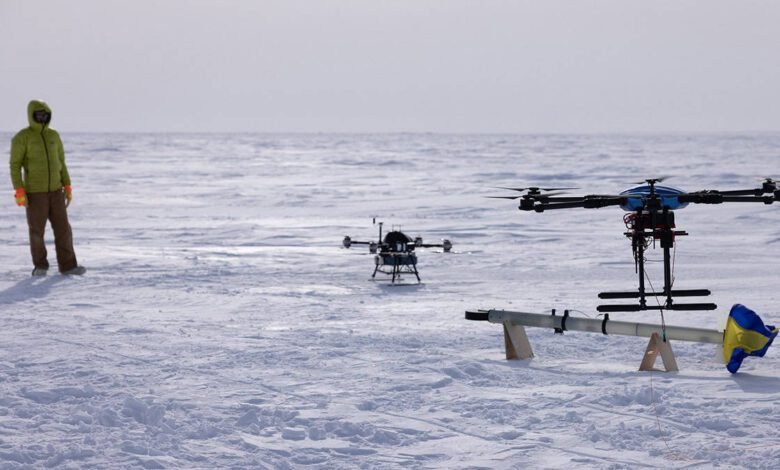Frozen ocean, solid science: UAF drones measure ice thickness

The electromagnetic induction instrument – nicknamed LEM, for LASSITOS EM – was in its final tests on this mission off the coast of the Arctic Ocean, Alaska.
Achille Capelli, postdoctoral fellow at the Geofísico Institute, designed and built the LEM over the last three years. Thimira Asurapmudalige, a doctoral student in electrical engineering at the UAF College of Engineering and Mines, has been helping.
How it works?
“The instrument is an electromagnetic probe that uses induction,” Capelli said after the first test flight of the year on Tuesday. “It fires a magnetic field and induces currents in the conductive seawater. These inductive currents induce a secondary magnetic field that tells us how deep the water surface is.”
The components sit inside a 4-inch-diameter, 9-foot-long fiberglass tube, with other parts produced on a 3D printer in the Geophysical Institute’s machine shop. A drag stabilizing skirt on the tail – in UAF blue and yellow colors – helps keep the instrument level during flight.
The LEM consists of a signal generator with a transmitting antenna and a receiver with antenna, digitizer and data logger. This device measures the distance to the ice-water interface.
The LEM also contains a laser altimeter to measure the distance to the surface of snow or ice. The difference between these two measurements corresponds to the total thickness of the ice and snow. A microprocessor is used to coordinate the different sensors.
Total weight is about 10 pounds.
On Tuesday, the tethered LEM flew 12 to 15 feet above the surface of the ice, which according to the holes was about 3 to 5 feet thick. The drone flew about three-tenths of a mile on a scheduled route diagonally from the berm- and ice-strewn coast, then returned.
The wind hit the drone and its dangling instrument, pushing the aircraft and instrument to their performance limits. The team knew from forecasts predicting winds of 20 to 30 mph that they would have little time to fly.
However, Capelli was pleased with the results.
“That’s good because it tells us what our limit is in the wind,” Capelli said. “I have to go back and analyze the data, but what I see now looks good.”
He added: “Hopefully we can have a few more flights this week and test all possible combinations of configurations.”
The prediction was on everyone’s mind. Strong winds were expected on Thursday. Wednesday, away from the city and on the Beaufort Sea, it was looking to be the best option for another instrument test.




